March 2023
- English
- 日本語
The History of Japanese Metalwork Using Gold

Kurokawa Hiroko, director of The University Art Museum, Tokyo University of the Arts 
Kusabana ni mushizu mitokoromono (insects and flowering plants sword fittings) by Goto Ichijo (1791–1876) of the Goto family, whose ancestor is Goto Yujo (Collection of Tokyo National Museum) (1858). Upper left (two items), menuki; upper right, kozuka; bottom, kogai
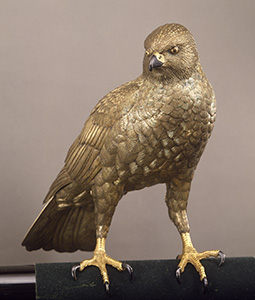
Twelve Bronze Falcons (part) by Suzuki Chokichi (1893), Important Cultural Property, Collection of National Crafts Museum 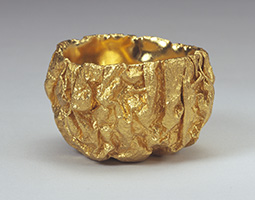
Ogon shuhai sake cup by Hiramatsu Yasuki (1993) (6.5 cm × 4.2 cm) 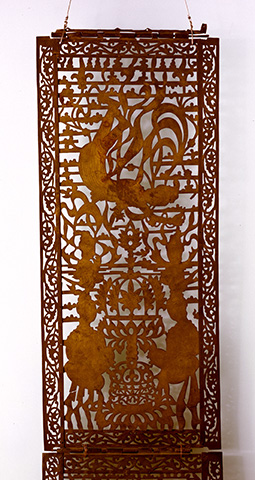
The 7th-century Buddhist Kanjo-ban banner (Collection of Tokyo National Museum) 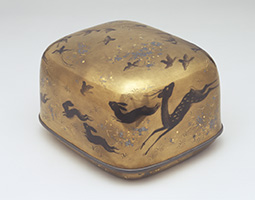
Small tebako (cosmetic box) with design of flowering plants, birds and animals by Matsuda Gonroku (1919) (23.5 cm × 21 cm × 15.8 cm) 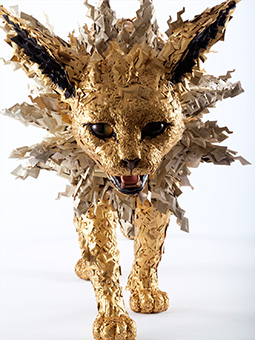
Jolteon by Yoshida Taiichiro (2022), private collection (65 cm × 50 cm × 115 cm)
©2023 Pokémon. ©1995–2023 Nintendo/Creatures Inc./GAME FREAK inc.
Photo: Saiki Taku

We spoke with Kurokawa Hiroko, director of The University Art Museum, Tokyo University of the Arts, about the history and distinctive features of Japanese metalwork that uses materials such as gold, silver, and copper.

When did today’s metalwork techniques first develop in Japan?
Many of the Japanese metalwork techniques that have been passed down to the present day come from techniques for making tosogu, which are ornamental metal fittings for swords made of gold and other metals. Sword fittings reached a stage of high development during a period of about 260 years, from the early 17th century to the mid-late 19th century, during the Edo period when Japan was ruled by the Tokugawa shogunate. In the Edo period, members of the samurai class always wore swords, so the demand for sword fittings was also high. As the techniques for making sword fittings developed, the workmanship of the fittings also became more elaborate.
Sword fittings for influential samurai such as shoguns and daimyo (feudal lords) were mainly made by the Goto family, going back to Goto Yujo (1440–1512). One of the characteristics of the Goto family’s sword fittings, such as the mitokoromono,* is the use of gold and shakudo, an alloy of gold and copper, as the main materials. However, in the middle of the Edo period, other schools of metalwork changed the combinations and amounts of metals such as gold, silver, and copper, using alloys of various colors to make colorful sword fittings.
During this period in the West, a variety of splendid ornaments using jewels were produced for the noble and wealthy, but jewelry was not made in Japan so much. However, metals such as gold, silver, and copper were used as materials for casting, forging** and engraving (see here) to create a wealth of stunning ornaments. Especially from the end of the Edo period to the Meiji period (1868–1912), when modernization began, it can be said that the technique reached its peak. However, there are few works that are decorated entirely with gold. Rather, most works use gold partially to make them shine slightly.
How did Japanese metalwork change during the modernization of the Meiji period?
With the beginning of the Meiji period, the era of the samurai ended. In 1876, the central government banned the wearing of swords except by military and police officers. As a result, the demand for sword fittings dropped sharply, so sword fitting craftsmen began to make ornaments such as obidome attached to the obi sash of kimono and craft items such as vases instead.
In the early Meiji period, in order to protect and encourage metalwork and other crafts, the government established companies to manufacture and export crafts, and also participated in overseas world expositions. In 1890, the government established the Imperial Court Artist System. This was a system that appointed as imperial court artists outstanding artists anticipated to set the standard in fields such as metalwork, painting, lacquerwork, ceramics, dyeing and weaving, the intention being to promote arts and crafts as well as pass on skills to future generations. By 1944, 79 imperial court artists had been appointed.
One metalworker appointed as one of the first imperial court artists in 1890 was Kano Natsuo (1828–1898), a sword fitting craftsman. Kano was able to freely manipulate the chisel as if it were a paintbrush, engraving pictures of animals and plants into metal. In recognition of his skill, Kano was tasked with designing the gold, silver, and copper coins issued by the government and engraving the design into the dies. It is said that European engineers invited by the government at that time to support the production of Japanese coins saw the dies and were astonished by the high level of Kano’s technique.
What other metalworkers would you cite as representative from the Meiji period onward?
For example, there’s Suzuki Chokichi (1848–1919), who was appointed imperial court artist in 1896. Suzuki exhibited his Twelve Bronze Falcons at the 1893 World’s Columbian Exposition in Chicago, where they were highly praised. Twelve Bronze Falcons are twelve falcons between around 40 to 50 cm high, made of materials such as gold, silver and shakudo. Having made these while keeping falcons at his home and observing them, they are very realistic and impressive. After seeing this work, many students resolved to study metalwork and entered Tokyo University of the Arts.

Another imperial court artist was Unno Shomin (1844–1915), who left behind flower vases, tobacco containers, rings, and other varicolored works made using gold, silver, copper, and alloys. One more metalworker, although not an imperial court artist, was Shoami Katsuyoshi (1832–1908), who was regarded as having skills comparable to Unno Shoami and who made full use of engraving techniques such as gold inlays (see here) to capture moments of creatures such as frogs and chickens in motion on vases, ashtrays, and other works.
Among recent creators, we have Hiramatsu Yasuki (1926–2012). A jewelry artist, Hiramatsu is highly regarded in Japan and abroad for his brooches, rings, and other works. Some of his works may surprise the viewer, with gold and other metals processed into unexpected shapes. One of them is the Ogon shuhai (golden sake cup) that uses thick gold leaf. The crumpled vessel looks so soft that you can’t believe it’s metal.

What are some good museums and galleries to see arts and crafts made with gold?
At the Gallery of Horyuji Treasures, a part of the Tokyo National Museum located in Ueno Park, Taito City, Tokyo, you can see the Kanjo-ban banner, which was made in the 7th century. The kanjo-ban is an ornament used in Buddhist ceremonies and consists of a copper plate in which various patterns have been cut before being gilded. The real object, which has been designated as a National Treasure, is currently exhibited in parts after having been disassembled, and there are faint remains of gold on some. Inside the museum, a gigantic replica of the Kanjo-ban banner, with a total length of about 5 m, is suspended from the ceiling. Looking at these things, you gain an appreciation for the extremely sophisticated metalwork techniques that already existed at the time. You could say it’s an indispensable work for discussing the history of metalwork in Japan.

At The University Art Museum, Tokyo University of the Arts, which is located near Tokyo National Museum and where I am the director, you can see various arts and crafts, although only during exhibition periods. This year (2023), “Selections from the Purchased Excellent Student Works” will be held from March 31 to May 7. Tokyo University of the Arts has a system for purchasing and storing the best works among those created by students when they graduate. In this exhibition, we will display carefully selected works out of more than 10,000 paintings, sculptures, metalworks, videos, and so forth purchased from students. One of the best works using gold on display is not metalwork but a maki-e*** box titled Small tebako (cosmetic box) with design of flowering plants, birds and animals by Matsuda Gonroku (1896–1986), who was later recognized as a holder of Important Intangible Cultural Property (Living National Treasure). The box depicts animals such as birds and deer that are full of dynamism, using a technique of sprinkling gold dust on the entire surface of the lacquer and scratching the outline of the animals with a wire in one go before the lacquer dries.

Various crafts are also on display at the National Crafts Museum in Kanazawa, Ishikawa Prefecture (see here). The exhibition “POKÉMON X KOGEI : Playful Encounters of Pokémon and Japanese Craft” to be held this year from March 21 to June 11 features Pokémon-themed works by 20 artists. You can see the metalworks of Yoshida Taiichiro, a graduate of Tokyo University of the Arts who uses an engraving technique to create three-dimensional works, and Katsura Morihito (see here), a Living National Treasure in the field of metal engraving.

©2023 Pokémon. ©1995–2023 Nintendo/Creatures Inc./GAME FREAK inc.
Photo: Saiki Taku
I think what is characteristic of Japanese crafts, including metalwork, is that objects are made very delicately, and that the attributes of the materials are utilized to the fullest. Above all, I would like you to enjoy the effects of gold and the rich colors created by various materials such as gold, silver, and copper. People normally consider metal to be hard and cold, but through the skill of Japanese metalworkers, I hope you will also notice that metals can be used to express softness, as with the Ogon shuhai sake cup I mentioned earlier. I would love people from overseas to see these wonderful Japanese crafts up close in Japan.
* See Highlighting Japan 2022 October “The Production and Use of Gold in Japan.” https://www.gov-online.go.jp/eng/publicity/book/hlj/html/202210/202210_01_en.html
** Metal casting is a technique in which metal is melted and poured into a mold to make a particular shape. Forging is a technique of striking the metal to make a particular shape.
*** See Highlighting Japan May 2022, The History and Culture of Lacquer in Japan https://www.gov-online.go.jp/eng/publicity/book/hlj/html/202205/202205_01_en.html

